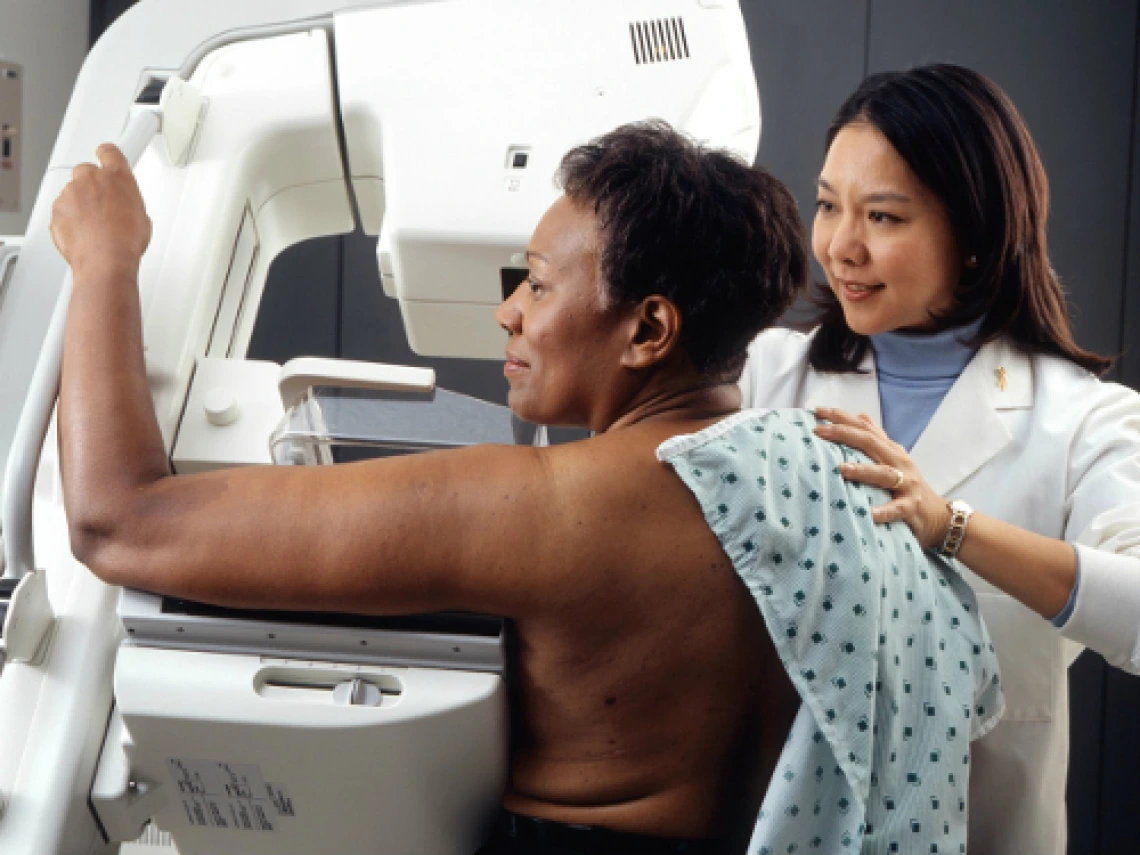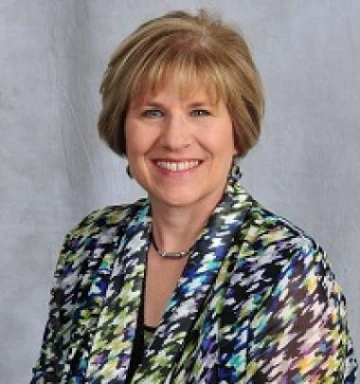Breast Cancer Risk Reduction: Tips from the UA Cancer Center

Contact: Anna C. Christensen, 520-626-6401, achristensen@arizona.edu
Dec. 5, 2017
TUCSON, Ariz. – Breast cancer is one of the most common cancers in the United States, striking 1 out of every 8

Beth High
women, according to the National Cancer Institute. The University of Arizona Cancer Center’s Beth High, MSN, breast oncology nurse navigator with the center’s Breast Cancer Multidisciplinary Clinic, tells us about strategies for reducing breast cancer risk and detecting it earlier.
First, the bad news. When it comes to breast cancer, there are some risk factors you have no control over — these include getting older, being born female or having certain harmful genetic mutations. No matter how hard you try, you can’t stop the aging process or reshuffle the base pairs of your genes.
The good news is that, despite factors like sex and age being out of your control, there are still steps you can take to reduce your risk of breast cancer.
Breast Cancer Risk Reduction Is for Everybody
A breast cancer diagnosis can be devastating.
“When I talk with a patient, she often wants to know, ‘What did I do? Why did I get cancer?’” says High. “There are risk factors that are associated with breast cancer, but other than a genetic mutation, it is nearly impossible to point to something causative. I tell my patients to avoid blaming themselves — it’s a very common disease.”
But, while breast cancer risk can’t be eliminated, it can be reduced. No matter who you are and what your perceived risk of breast cancer is, your overall health will benefit when you make a few changes to your lifestyle.
One of the first steps you might take is to moderate your alcohol consumption. A clear link exists between increased alcohol use and breast cancer.
“One drink a day is considered safe for women,” says High. According to the Centers for Disease Control and Prevention, one drink is 12 ounces of beer, 8 ounces of malt liquor, 5 ounces of wine, or 1.5 ounces of distilled spirits or liquor.
“One a day,” repeats High. “You can’t save them all up and have seven on Saturday.”
Quitting smoking — or not starting in the first place — is another slam dunk for your health. While the jury is out on whether or not smoking is positively linked to higher breast cancer risk, we do know that quitting now will lower your risk of death if you are diagnosed with breast cancer. Furthermore, your smoking status could limit the types of treatments you can get after a breast cancer diagnosis. Smokers may have to go a month or more without smoking before receiving certain surgeries.
“Women smokers who have mastectomies aren’t candidates for certain types of reconstruction because smoking impairs wound healing,” says High.
High believes in moderation: “Women do not need to live Spartan lives, but they should strive to live healthy ones,” she says. “Regular exercise and eating a more plant-based diet are important for everyone.”
Estrogen Exposure: Weighing Your Options
While everyone would benefit from the above lifestyle changes, there are other risk-reduction strategies that are more specific to breast cancer. They involve your direct exposure to estrogen, a hormone that stimulates the growth of breast cells.
First of all, overweight or obese postmenopausal women have an increased risk of breast cancer, as fat tissue can produce estrogen, a hormone that stimulates the growth of breast cells. After menopause, the ovaries stop producing estrogen, but it continues to be produced by adipose tissue (fat).
“The more adipose tissue you have, the higher your levels of circulating estrogen,” says High. “This alone may increase your chances of developing breast cancer.”
Secondly, for women who have children, breastfeeding reduces breast cancer risk. According to the American Cancer Society, breastfeeding for 1½ to 2 years might confer the most benefit. “The longer you breastfeed, the less exposure to estrogen you will have,” says High.
Finally, the long-term use of hormonal therapy to help with menopause symptoms prolongs estrogen exposure, raising breast cancer risk. “Doctors are not prescribing this type of therapy so much anymore,” says High, “but some people need it to counterbalance life-altering effects of menopause: severe mood changes, vaginal dryness, and hot flashes that disrupt their lives and affect their sleep.”
Many people are concerned that the birth control pill increases breast cancer risk, but the association between the two isn’t clear. While some types of oral contraceptives have been found to raise breast cancer risk, they’re not thought to raise risk by much — less than 1 percent.
“You have to weigh the risk and the benefit,” says High. “Each woman needs to consider for herself the slim chance that taking birth control pills might be associated with breast cancer, versus experiencing an unwanted pregnancy that has the potential for health risks and lifestyle repercussions, versus alternative birth control methods.”
Mammograms for Early Detection
Leading a healthy lifestyle and reducing estrogen exposure is nowhere close to a guarantee that you won’t get breast cancer — and in that case, early detection may help catch cancers when they are smaller and easier to treat.
“Get your mammograms when your doctor recommends,” says High. “It’s possible to cure small breast cancers that are only in the breast.”
The UA Cancer Center breast cancer team follows National Comprehensive Cancer Network’s recommendations to begin mammography at age 40, and encourages patients to receive annual mammograms until their health reaches a state at which someone would opt against treatment even if a cancer were found.
“We don’t say, ‘stop getting mammograms at 75.’ If you’re hale and hardy and out hiking Sabino Canyon, by all means, get your mammogram,” says High. “But if you’re 89 years old and have debilitating illnesses that would affect your ability to tolerate treatment, you might want to forgo mammograms. That’s a decision each patient has to make with her doctor.”
Special Strategies for High-Risk Patients
The UA Cancer Center has a High-Risk Cancer Genetics Clinic to identify patients at a particularly high risk for breast cancer. The clinic offers increased screening, risk-reducing therapy and prophylactic (or preventive) surgery.
“Of all the breast cancers that there are, only about 10 percent have that BRCA mutation,” says High, referring to the infamous genetic mutation that made headlines when Angelina Jolie revealed that her mutated BRCA-1 gene gave her an 87 percent risk for breast cancer.
“If somebody has a strong family history, we send them to a genetic counselor,” explains High. “If they meet very specific criteria, a blood sample is sent for genetic testing. If the test shows a genetic mutation, then we discuss risk-reducing therapy such as tamoxifen and surgery. Close monitoring always is part of the plan.”
Close monitoring involves more frequent mammograms, including 3-D mammograms, or MRIs for people with dense breasts, which are composed of more supportive tissue than fatty tissue and are difficult to visualize on mammograms. Risk-reducing therapy includes daily pills that block or reduce estrogen. Someone with an especially high proclivity for breast cancer could see a significant reduction in their absolute risk.
Finally, surgical removal of breasts reduces breast cancer risk by as much as 97 percent. “There’s still a small chance that some breast tissue is left behind, so we continue to monitor for any signs of breast cancer,” says High.
“Having prophylactic surgery to remove both your breasts is a big deal,” High continues. “It’s a personal choice, and it should be made in consultation with the entire multidisciplinary team of medical oncologist, breast surgeon and genetic counselor. There are women who get so anxious about their annual mammogram that they just can’t cope. For them, having that surgery is the only way they dispel that anxiety.”
To Learn More
For more information about breast cancer detection and treatment, please visit the UA Cancer Center website.
About the University of Arizona Cancer Center
The University of Arizona Cancer Center is the only National Cancer Institute-designated Comprehensive Cancer Center with headquarters in Arizona. The UArizona Cancer Center is supported by NCI Cancer Center Support Grant No. CA023074. With its primary location at the University of Arizona in Tucson, the Cancer Center has more than a dozen research and education offices throughout the state, with more than 300 physicians and scientists working together to prevent and cure cancer. For more information: cancercenter.arizona.edu (Follow us: Facebook | Twitter | YouTube).
About the University of Arizona Health Sciences
The University of Arizona Health Sciences is the statewide leader in biomedical research and health professions training. The UA Health Sciences includes the UA Colleges of Medicine (Phoenix and Tucson), Nursing, Pharmacy and Mel and Enid Zuckerman College of Public Health, with main campus locations in Tucson and the growing Phoenix Biomedical Campus in downtown Phoenix. From these vantage points, the UA Health Sciences reaches across the state of Arizona and the greater Southwest to provide cutting-edge health education, research, patient care and community outreach services. A major economic engine, the UA Health Sciences employs almost 5,000 people, has nearly 1,000 faculty members and garners more than $126 million in research grants and contracts annually. For more information: uahs.arizona.edu (Follow us: Facebook | Twitter | YouTube | LinkedIn)
Photo 1: Beth High, MSN
Photo 2: Credit: Rhoda Baer, National Cancer Institute

